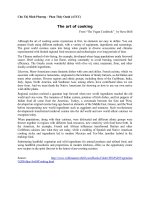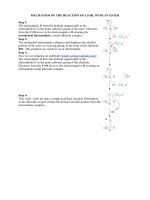THE PRINCIPLE OF LEVERACE
Bạn đang xem bản rút gọn của tài liệu. Xem và tải ngay bản đầy đủ của tài liệu tại đây (273.28 KB, 13 trang )
17. září 2004
101 ze 412
7
THE PRINCIPLE OF
LEVERAGE
To me, bottom line of systems thinking is leverage—seeing where
actions and changes in structures can lead to significant, enduring
improvements. Often, leverage, follows the principle of economy of
means: where the best results come not from large-scale efforts but
from small well-focused actions. Our nonsystemic ways of thinking are
so damaging specifically because they consistently lead us to focus on
low-leverage changes: we focus on symptoms where the stress is
greatest. We repair or ameliorate the symptoms. But such efforts only
make matters better in the short run, at best, and worse in the long
run.
It's hard to disagree with the principle of leverage. But the leverage in
most real-life systems, such as most organizations, is not obvious to
most of the actors in those systems. They don't see the "structures"
underlying their actions. The purpose of the systems archetypes,
such as limits to growth and shifting the burden, is to help see those
structures and thus find the leverage, especially amid the pressures
and crosscurrents of real-life business situations.
17. září 2004
102 ze 412
For example, let's look at a real story that we have seen again and
again. In fact, the following case is a mosaic pieced together from
several specific instances where the same story unfolded.
1
WHEN WE CREATE OUR OWN
"MARKET LIMITATIONS"
In the mid-1960s a new electronics company was founded with a
unique high-tech product—a new type of computer. Thanks to its
engineering know-how, WonderTech had a virtual lock on its market
niche. There was enormous demand for its products, and there were
enough investors to guarantee no financial constraints.
Yet the company, which began with meteoric growth, never sus-
tained its rapid growth after its first three years. Eventually it declined
into bankruptcy.
That fate would have seemed unthinkable during WonderTech's
first three years, when sales doubled annually. In fact, sales were so
good that backlogs of orders began to pile up midway through their
second year. Even with steadily increasing manufacturing capacity
(more factories, more shifts, more advanced technology), the demand
grew so fast that delivery times slipped a bit. Originally they had
promised to deliver machines within eight weeks, and they intended
to return to that standard; but with some pride, the top management
told investors, "Our computers are so good that some customers
are willing to wait fourteen weeks for them. We know it's a problem,
and we're working to fix it, but nonetheless they're still glad to get the
machines, and they love 'em when they get 'em."
The top management knew that they had to add production capacity.
After six months of study, while manufacturing changed from a one-
shift to a two-shift operation, they decided to borrow the money to
build a new factory. To make sure the growth kept up, they
pumped much of the incoming revenue directly back into sales and
marketing. Since the company sold its products only through a direct
sales force, that meant hiring and training more sales people. During the
company's third year, the sales force doubled.
But despite this, sales started to slump at the end of the third year.
17. září 2004
103 ze 412
At this point, the new factory came on-line. "We've hired all these
people," said the vice president of manufacturing. "What are we
going to do with them?" The top management began to panic about
what to tell their investors, after they had spent all this money on a
new manufacturing facility. It was as if everyone in the company
simultaneously turned and looked at one person: the marketing and
sales vice president.
Not surprisingly, the marketing and sales VP had become a rising
star in the company. His force had done so well during the initial
boom that he had anticipated a promotion. Now there was a slump,
and he was under heat to turn sales around. So he took the most
likely course of action. He held high-powered sales meetings with a
single message: "Sell! Sell! Sell!" He fired the low performers. He
increased sales incentives, added special discounts, and ran new
advertising promotions describing the machine in an exciting new way.
And indeed, sales rose again. The sales and marketing VP found
himself once more hailed as a hero, a born-again motivator who
could take charge of a tough situation. Once again, WonderTech was in
the happy position of having rapidly rising orders. Eventually, backlogs
began to grow again. And after a year, delivery times began to rise
again—first to ten weeks, then to twelve, and eventually to sixteen.
The debate over adding capacity started anew. But this time, having
been stung on the last occasion, the top management was still more
cautious. Eventually, approval of a new facility was granted, but no
sooner had the papers been signed than a new sales crisis started. The
slump was so bad that the sales and marketing vice president lost his
job.
Over the next several years, and through a succession of marketing
managers, the same situation recurred. High sales growth oc-
By the middle of the fourth year, sales had dropped off to crisis
levels. The curve of sales, so far, looked like this:
17. září 2004
104 ze 412
The company prospered modestly, but never came close to fulfilling
its original potential. Gradually, the top managers began to fear that
other firms would learn how to produce competing products. They
frantically introduced ill-conceived improvements in the product. They
continued to push hard on marketing. But sales never returned to the
original rate of growth. The "wonder" went out of WonderTech.
Eventually, the company collapsed.
In his final statement to the lingering members of his executive
team, the CEO said, "We did great under the circumstances, but the
demand just isn't there. Clearly it was a limited market—a niche
which we have effectively filled."
The tale of WonderTech is hardly a novel one. Of every ten startup
companies, one half will disappear within their first five years, only
four survive into their tenth year, and only three into their fifteenth
year.
2
Whenever a company fails, people always point to specific events
to explain the "causes" of the failure: product problems, inept
managers, loss of key people, unexpectedly aggressive competition, or
business downturns. Yet, the deeper systemic causes for
unsustained growth are not recognized. With the aid of the
systems archetypes, these causes often can be understood and, in
many cases, successful policies can be formulated. The irony of
WonderTech is that, given its product and its market potential, it could
have grown vigorously for many years, not just two or three.
WonderTech's managers could not see the reasons for their own
decline. This was not for lack of information. They had all the signif-
icant facts—the same facts that you have after reading this story.
But they could not see the structures implicit in those facts.
As a systems thinker trying to diagnose WonderTech's problem,
you would look for clues—anything that might suggest an archetype.
curred in spurts, always followed by periods of low or no growth.
The pattern looked like this:
17. září 2004
105 ze 412
You'd begin
with the most obvious pattern
ofiPPbr.
growth
leaped
up at first, amplifying itself to grow stronger and stronger.
But
the growth gradually
slowed, and eventually
sales stopped growing
altogether.
This pattern is the classic symptom of limits to
growth.
There are many possible reinforcing (amplifying) processes that
could have produced WonderTech's original rapid sales growth. In-
vestment in products, investment in advertising, good word of mouth
—all could have reinforced past success into future success. But one
especially evident in the WonderTech story was the reinforcing process
created by investing revenues in increasing the sales force: more
sales meant more revenues, which meant hiring salespeople, which
meant more sales.
The other part of any limits to growth structure, of course, is a
balancing (stabilizing) process. Something had to make the sales slow
down. But sales only slow down when a market is saturated, when
competition grows, or when customers grow disenchanted. In this
case, the need for the WonderTech computer was still strong, and
there was no significant competition. There was one factor which
turned customers off: long delivery times. As backlogs rise relative to
production capacity, delivery times increase. A reputation for poor
delivery service builds, eventually making it harder for WonderTech's
salespeople to make more sales. The limits to growth structure, then,
looks like this:









